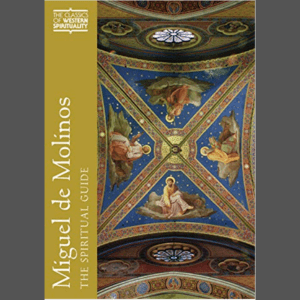The Spiritual Guide By Miguel de Molinos: A Journey into Contemplative Silence

Miguel de Molinos, a 17th-century Spanish mystic, remains an enigmatic and controversial figure within Catholicism. His book, “The Spiritual Guide”, published in 1675, became a spiritual phenomenon, translated into multiple languages and followed by a large following. Yet, within a decade, Molinos faced accusations of heresy and was imprisoned until his death. This review delves into the core teachings of “The Spiritual Guide” and explores the reasons behind its enduring influence despite its condemnation.
Key Teachings of “The Spiritual Guide”
The Path of Inner Silence
Molinos’ central message revolves around the concept of “interior recollection” – a practice of attentive inner silence. He emphasizes that the divine resides within us, urging readers to look inward through self-reflection and remain in a state of complete surrender. This quiet contemplation, he argues, surpasses both intellectual meditation and prayerful discourse. Here, the soul desires nothing, seeks nothing. It merely rests in the silent embrace of God. In this stillness, love blossoms. Molinos writes, “The perfection of the soul does not consist in speaking or in thinking much on God, but in loving Him much.” This profound simplicity contrasts with the complexities of traditional meditation and discursive prayer.
Interior Recollection vs. Meditation
Meditation involves deliberate thought, focusing on specific spiritual topics. Molinos, however, advocates for a more direct path—an intimate gaze within. By turning inward, we discover the divine presence residing in our hearts. The soul’s perfection, he contends, lies not in excessive mental activity but in profound love for God.
The Dark Night of the Soul
The path outlined in “The Spiritual Guide” is not without challenges. Molinos acknowledges periods of “darkness, dryness, and temptations” that every seeker will encounter. He assures readers that such experiences are not signs of failure but are orchestrated by God for spiritual growth, guiding them towards the path of paradise. This concept resonates with the idea of the “Dark Night of the Soul,” a period of spiritual desolation described by mystics throughout history.
Rather than resisting temptations, Molinos suggests embracing them as opportunities for spiritual growth. He emphasizes the importance of remaining at peace and not engaging with deceptive thoughts.
Types of Prayer
He distinguishes between two types of prayer: tender, easy prayer for beginners and obscure, dry prayer for those on the path to perfection. Molinos views these challenges as purification methods to strengthen the soul.
The Role of the Spiritual Guide and the Dangers of External Knowledge
Molinos emphasizes the importance of a spiritual guide for navigating the “interior path.” He warns against relying solely on one’s own judgment and advises seeking guidance from someone experienced in the mystical way. He extends this caution to spiritual books, arguing that excessive knowledge from external sources can hinder the soul’s journey inward.
Union with the Divine and the Price of Transformation
The final section of “The Spiritual Guide” explores the experiences of those who have reached a state of “agreeableness to God.” Molinos describes a deep connection with the divine, often accompanied by a sense of both immense love and longing, describing mystical encounters and the soul’s journey towards loving union with the divine. This state, however, comes at a cost. He describes a spiritual martyrdom – a period of intense inner struggle characterized by feelings of abandonment, self-doubt, and despair. This suffering, Molinos argues, is necessary for complete purification and union with God. He advocates for surrendering oneself entirely to God, stripping away the ego for divine communion.
A Legacy of Controversy
Molinos’s life unfolded against a backdrop of theological upheaval and political intrigue. As a spiritual guide, he attracted a diverse following, including influential Church officials. Molinos’ emphasis on inner experience and the potential dangers of external religious practices clashed with the established Catholic doctrines of the time. Fearing a loss of control and potential heresy, the Church condemned his teachings as “quietism”. The Catholic Church banned his book, yet its influence persisted, inspiring numerous mystics throughout the centuries. Protestant circles embraced Molinos’s teachings, perpetuating Quietism. The recent Paulist Press edition offers a fresh translation, allowing modern readers to explore the mystical depths of Molinos’s wisdom.
Why Read “The Spiritual Guide” Today?
Despite its historical controversy, “The Spiritual Guide” offers timeless wisdom for anyone seeking a deeper connection with the divine. Molinos’ call for inner silence and self-surrender resonates across religious traditions. The book challenges readers to look beyond external rituals and doctrines and embark on a path of personal exploration. Whether from a Christian perspective or a broader spiritual viewpoint, “The Spiritual Guide” offers valuable insights for those seeking a more authentic and transformative relationship with the sacred.
Further Exploration
This review provides a brief glimpse into the depths explored by Miguel de Molinos in “The Spiritual Guide.” Those interested in a deeper understanding can explore the newly translated version published by Paulist Press. Click here to purchase “The Spiritual Guide” from Amazon.
Miguel de Molinos, the quiet revolutionary, beckons us to silence—the fertile ground where the soul encounters God. As we journey through The Spiritual Guide, we find not mere words but an invitation to dwell in the sacred stillness within. Perhaps, in embracing this contemplative path, we too can touch the divine and discover the kingdom of God—the silent sanctuary of our souls.
Frequently Asked Questions
- Who was Miguel de Molinos?
Miguel de Molinos was a Spanish mystic known for his controversial teachings on inner silence and contemplative practices.
- What is Quietism?
Quietism refers to the mystical teachings emphasizing passive contemplation and inner silence, often associated with Molinos’ beliefs.
- What are the key teachings of “The Spiritual Guide”?
The book focuses on the soul’s centrality as God’s residence, interior recollection, embracing challenges, and the role of a spiritual guide.
- Why was Molinos condemned for heresy?
Molinos was tried for heresy due to his controversial teachings, leading to his imprisonment and the banning of his book by the Catholic Church.
- How did “The Spiritual Guide” impact Protestant circles?
Despite being banned by the Catholic Church, Molinos’ book continued to influence Protestant spirituality, reflecting its enduring appeal and relevance.


Hey very cool web site!! Man .. Beautiful .. Amazing .. I will bookmark your blog and take the feeds also…I am happy to find a lot of useful information here in the post, we need work out more strategies in this regard, thanks for sharing. . . . . .
I was suggested this web site by means of my cousin. I am not positive whether this publish is written by means of him as nobody else recognise such specific approximately my difficulty. You are wonderful! Thanks!
I used to be recommended this web site by means of my cousin. I’m now not certain whether or not this post is written by way of him as nobody else recognise such targeted approximately my problem. You’re amazing! Thank you!
Thank you for sharing with us, I believe this website really stands out : D.
Just here to join conversations, share thoughts, and gain fresh perspectives along the way.
I’m interested in hearing diverse viewpoints and sharing my input when it’s helpful. Happy to hear different experiences and building connections.
Here is my web-site-https://automisto24.com.ua/
hey there and thank you for your information – I’ve definitely picked up anything new from right here. I did however expertise several technical points using this web site, as I experienced to reload the website many times previous to I could get it to load correctly. I had been wondering if your web hosting is OK? Not that I’m complaining, but slow loading instances times will often affect your placement in google and could damage your high-quality score if ads and marketing with Adwords. Well I am adding this RSS to my email and could look out for much more of your respective exciting content. Make sure you update this again very soon..
It’s hard to find knowledgeable people on this topic, but you sound like you know what you’re talking about! Thanks
I’ve recently started a site, the info you offer on this website has helped me tremendously. Thank you for all of your time & work.
Heya i’m for the primary time here. I came across this board and I find It truly useful & it helped me out much. I’m hoping to give something again and aid others such as you aided me.
You have brought up a very wonderful details , thanks for the post.
Definitely believe that which you said. Your favorite justification appeared to be on the net the simplest thing to be aware of. I say to you, I definitely get irked while people think about worries that they plainly don’t know about. You managed to hit the nail upon the top as well as defined out the whole thing without having side effect , people could take a signal. Will probably be back to get more. Thanks